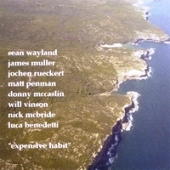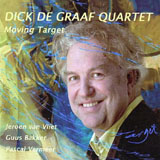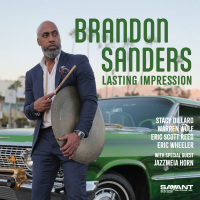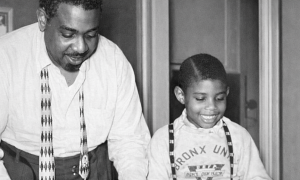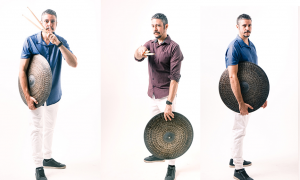Home » Jazz Articles » Interview » Miroslav Vitous: It Comes Down to Taste
Miroslav Vitous: It Comes Down to Taste
A lot of people try to put classical and jazz music together. It's always two different musics put together, not one music. I think it is one music, and partly because I am that one musician who is classical and also a creative force. I am both.
 You can't ask for a more interesting interview subject than Miroslav Vitous, but anyone in search of self-deprecation or false modesty would be best advised to seek elsewhere. Simply put, Miroslav Vitous believes in Miroslav Vitous; he believes—no, knows—that his work is important, and he will not waste a moment pretending otherwise.
You can't ask for a more interesting interview subject than Miroslav Vitous, but anyone in search of self-deprecation or false modesty would be best advised to seek elsewhere. Simply put, Miroslav Vitous believes in Miroslav Vitous; he believes—no, knows—that his work is important, and he will not waste a moment pretending otherwise.That's not terribly surprising, since the 60-year-old, Czech-born bassist and composer's resume places him dead-center in some very important musical settings and movements. Vitous was playing violin at age six, piano at age ten, and had settled upon bass—the instrument he's made his name playing—by the age of 14. He studied at the notoriously-rigorous Prague Conservatory under the great double bassist Frantis?ek Pos?ta, and his accomplishments in Prague pushed him on to Boston, where he studied at the Berklee College of Music.
Suddenly, the European bassist (who had already played in an excellent group on the Continent with his brother Alan and future fusion keyboard star Jan Hammer) was playing with some of the heavyweights of late 1960s jazz: Miles Davis, Herbie Mann, Bob Brookmeyer and Stan Getz. Keyboardist Chick Corea's near-perfect 1968 record Now He Sings, Now He Sobs, a trio set with drummer Roy Haynes and Vitous, showcases the characteristics that made Vitous such a hot property: rigorous, fearless technique, impeccable rhythm coupled with fascinating melodic patterning, and a carnivore's appetite for improvisation.
The electric jazz movement was in full flower in the late 1960s, and while Vitous didn't play on Miles Davis' epochal 1970 Bitches Brew, keyboardist Joe Zawinul and saxman Wayne Shorter did. Shortly after Vitous' own 1970 debut recording Infinite Search, which demonstrated that he was as able a composer as he was a player, Vitous and Shorter performed on Zawinul's own 1971 debut Zawinul. The three musicians joined formally to create the enormously successful band Weather Report.
While the other two founding members of the band stayed with the group until its 1980s demise, Vitous' final recording with Weather Report was the 1974 Mysterious Traveller, where he only played on one track. But the Vitous-era Weather Report remains beloved of music fans, and one only need listen to the 1972 Live in Tokyo to hear why. This was fierce, even frightening music, and Vitous' bass improvisations were an essential part of the band's roaring attack.
Vitous produced some marvelous recordings under his own name throughout the 1970s—Magical Shepherd (Warner Bros., 1976) and Miroslav (Arista Freedom, 1977) come to mind most readily. But the late 1970s saw the beginning of Vitous' real association with ECM Records, a label for which he records to this day. Vitous remains particularly associated with ECM labelmate Jan Garbarek, and his 2003 ECM record Universal Syncopations featured longtime musical associates Chick Corea, John McLaughlin, and Jack DeJohnette. It's as strong as any of Vitous' previous recordings.
But the 2007 sequel-of-sorts, Universal Syncopations II, is something altogether different. Although Vitous regards it as a continuation of the first Syncopations, its ambitions are far greater, and so are its achievements.
Simply put, Vitous is attempting to do what so many have attempted, and what so few have done: to fuse classical and jazz musics into one organic form. And remarkably, he's done it. There's much more to say about this fascinating CD, but it's all in the interview below, so read on.
Chapter Index
Universal Syncopations II: New Classical Forms
Choosing Musicians and Some Details about the Tunes
The Importance of Mixing, Drum Puzzles and Matters of Taste
A New Music: Neither Jazz Nor Classical
Recreating the Music Live: Difficult, But Not Impossible
Vitous as Bassist: The Return of Arco
Universal Syncopations II: New Classical Forms
All About Jazz: I think we're going to be talking at length about your new CD, Universal Syncopations II.
This record shares the title of your 2003 CD Universal Syncopations, but the two recordings are quite different. That one consisted of small group performances where the parts were often recorded separately. This one consists of various small groups of less-famous but equally fantastic players—drummer Gerald Cleaver and saxophonist Gary Campbell, for example—recorded mostly live, together with you, with some remarkable orchestrations overdubbed after the fact—orchestrations you had sketched out using your own Library of Orchestra Samples.
I think this is one of your most original-sounding records, and at the moment, I think it's your best record. I hope you're very proud of it.
Miroslav Vitous: Thank you very much. I am, yes.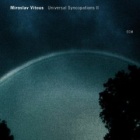
AAJ: Although it does consist of these orchestrations over or alongside these frequently restless, almost free-boppy small group performances, the collective result is something really new and very beautiful, and the parts go together to the point of all the voices commenting on each other or playing at times in unison. It's a perfect unity of brief, concise lines adding up to one harmonic, melodic whole. There are orchestral and chromatic colors in a very nonclassical and swinging setting.
Tell me how you conceived this project. It certainly sounds as if you always knew how all the parts would sound before you began. How was it written and recorded?
MV: Well, it was basically a continuation of the first Universal Syncopations record. It just went a little bit farther. I had already wanted to use some symphonic sounds on that first recording, but there was really no room there for that. But I did want to have a classical sound there—I'm interested in using a classical form, but not a classical form like sonata or something like that. I'm looking for a new form, with a creative force. I think this is the future of music; everything else has been used up, so this is the only way to go now to get something new. And to grow—not just get something new, but to grow.
So since there was no space on the first recording, I planned to use a lot of orchestra on this second one. I wanted to have a lot of orchestra playing with the group, and to explore a different way of using a rhythm section—you know, bass and drums. You might notice that, on the recordings, we don't play time in the traditional jazz way. We play in a way that is free, but is not free, and it creates a sort of plasmic support for the music. At the same time, it is interactive and very strongly communicative on a creative level.
That's also a very new thing. I was very happy to discover it with Gerald Cleaver. We talked about it, rehearsed a few things, and decided to play like that. His way of playing drums is so free that it fits with that way of doing things that I just described to you, and you get this new sort of rhythm section. It really breaks the barrier of those slave rhythm sections that we've had for so many years in jazz. It's the end of slavery, so to speak [laughing].
AAJ:The Great Emancipation.
MV: It's really true. If you carefully analyze jazz, you'll find that the rhythm section is a slave unit. There are many roles in jazz, but in this music, there are no roles. Everything lives on its own, by itself, but fits exactly together—just like life! So that's the idea. I wanted the music to be very natural.
And the music should come to us in waves. It doesn't come to us as if we stick a finger in a light socket on the wall—bzzzzzt. It comes in waves! This is the way the music should be played, I believe. It feels more natural than to just play something that just repeats and repeats. Repetition is very dangerous. It's not natural, and I feel it's where the human race is going wrong. It's not the way nature is; it's not the way the universe is. It's not the way we are.
So I'm trying to play music that is more like we are and the universe is. As far as the pieces are concerned, they were generated in a few different ways. One way was just adding orchestrations based on ideas that I had. The other was basically playing over already-existing orchestrated tunes. The second tune ["Breakthrough"] and the fourth piece ["Solar Giant"] we recorded over some of my prerecorded library sounds. So we heard some of the orchestra in the headphones as we played, and the structure was already there. We just had to fill it in, so to speak.
AAJ: I see. I assumed that all the orchestrations were overdubbed after the fact.
MV: Not on number two, number three ["The Prayer"] and number four. I think that's quite important, too. On the rest of them, it was done that way, because there was no other way possible. But on those three, the orchestra was already prerecorded. Actually, I changed most of the orchestral parts afterwards, to improve them, and some of them were completely changed.
But it doesn't matter; that makes no difference, because the idea was that we were playing with the orchestra and creating space with the orchestra.
AAJ: Actually, it's a very flexible way to work. The group plays, responding to orchestrations, and then you might change the orchestrations to further respond to the group.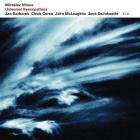
MV: Exactly. So "Opera" was basically created completely live with [drummer] Adam Nussbaum and [reeds player] Bob Mintzer. Bob played that solo completely live. Maybe there was one bar or something taken out or something like that, but otherwise it was exactly like he played it. Then [trumpeter] Randy Brecker overdubbed his solo, [saxophonist] Gary Campbell overdubbed some things, and the orchestra was added later.
AAJ: The vocal choir seems to be actually responding to the performance.
MV: Oh, I remember now. I forgot, because to me it doesn't matter, but there were some orchestral statements on "Opera" already done that we were responding to. We could hear those parts in the headphones, and that choir you're talking about was already recorded and in our headphones. We played with the choir.
AAJ: It sounds like the voices are responding to Randy Brecker's solo.
MV: Oh, you mean the sound effects. Those bits were done later. I put those in to respond to Randy. But the first melody was recorded live, just as it is. That choir melody was recorded before the group.
AAJ: I know that your own Miroslav Vitous Symphonic Orchestra Samples were a huge tool in creating this music, but when we're talking about the choir on "Opera," for example, we are not hearing samples, are we? We're hearing live vocalists, aren't we?
MV: Yes, you are hearing live vocalists. A choir was used. But we don't have to call any of that stuff "samples," because whatever I use was recorded just like what you're hearing. This is where we come to the question of the difference between a sample and a live performance, because when you get to the bottom of what this music is is something that had to be recorded by live musicians anyway, whether it's sampled or not! So it doesn't really matter, does it? The outcome is what is important.
class="f-right">
Choosing Musicians and Some Details about the Tunes
AAJ: Tell me more about the musicians you chose for this project. You mentioned Gerald Cleaver already, and I think he's a very important part of this album. He plays both very classically in some ways, and at the same time, in a very nonclassical manner. Tell me how you chose the players for these tracks, and more about what you wanted to achieve from the performances.
MV: As I said before, Gerald Cleaver really interested me with the way he played. It was very free, and when I heard him play, I recognized that it would match with my playing very well, because I'm also free—but coming from a more classical place. He's free, coming from free music, and I'm free, coming from classical. At the same time, he has a pretty big knowledge of classical music. He knows how to play like that. So I thought he'd be a real asset.
Both Gary Campbell and Gerald Clever were members of my band when we did the album. So I'd already chosen them before, and we'd played together before this recording, and the album was an outcome of the playing we'd already done. It wasn't the first time we played together. So they were the nucleus for the whole album—the band. It's basically that trio and the orchestra, and that's the real breakthrough to me.
And Bob Mintzer and Randy Brecker were just guests. They appear on some songs. I think Bob Mintzer is a fantastic asset—his bass clarinet playing on "Universal Evolution" really creates another dimension that was exactly what I was looking for. He understood perfectly what I asked him to do. He's really a fantastic musician.
Adam Nussbaum played instead of Gerald on "Opera" because he was still playing in the band at that time. "Opera" was the first piece recorded on this album, and Adam was in the group then. That's why he's on "Opera," and not on the other tracks.
And [saxophonist] Bob Malach's on the last piece ["Moment"]. I always wanted to do something with him. He was in my group some time before that, and I really liked the way he played melody. He's got this Polish soul, which is very close to my Slavic roots. I love the way he plays melody. So I called him. We had said to each other, "One day we're going to record the most beautiful melody together." That was thirty years ago when we were on a tour of Europe, playing with [drummer] Alphonse Mouzon. So he came to just record that one piece with me. There was actually another tune that we recorded at the time, but it didn't make it to the album—it didn't really fit the final concept of the whole album.
The vocal was added on at the last moment to that piece, "Moment," because I heard this singer in Prague, Vesna Vasko-Caceres, and she was very impressive. So I wanted to do something with her. But when we started to record, the voice didn't really fit with everything as a solo element. So I said, "Well, I guess this is not going to work," because the solo voice didn't fit. But when I listened to it later—she had recorded the same thing over and over, about four or five times, and I played all of the takes by accident together. All of a sudden I had a choir of her, and I heard it together with the track and said, "Wait a minute—this is it." I realized I would put her in the background, using her voice as a choir. It fit perfectly with what I was looking for. It was like that white ghost—you know, the woman in the forest. I only know the word in Czech: veela.
So that covers all the musicians on the album. I basically knew what was needed for each piece. And there's that tune, "Gmoong," which is just the trio of me, Mintzer and Brecker. Some orchestra was added to that one later, but we actually recorded that tune to those chords—those haunting chords in the background that basically just keep repeating.
This was the only piece that was done in a whole other way, which was that I had these chords, which I recorded, and then I had Randy Brecker improvise to that and play a few melodies that I wrote. Then I did the same with Bob Mintzer: improvise, and play a few melodies that I wrote. Then I did the same thing over them, playing myself. Then I took the tracks and put together something which would go together. It was not very difficult, because the inspiration from those chords was so strong. They made such an atmosphere that we were all influenced by the same thing, and it was just a matter of moving a few lines here and there. Everything fit together. Then I added a few orchestra parts to glue it together and improve it, and there was the piece. So that was done in a completely different way from the other ones.
class="f-right">
The Importance of Mixing, Drum Puzzles and Matters of Taste
AAJ: It's becoming apparent that you are using your studio as a very significant part of your work, for composition, editing and arrangement. This album has a perfect mix. I love the balance of instruments, your bass in particular, and the use of stereo in the orchestral parts. How much time did you spend mixing this record?
MV: Well, you're right—the mixing was very difficult. We actually spent quite a bit of time, because I was premixing the whole time that I was working on the tracks—I was already adjusting the levels. Then I think we mixed for five days or something to get it to a certain point, and then a while after that, we mixed for another five days to really finish it.
So that's ten days. Then we had to another three days to deal with some things. "Evolution" was very difficult to mix, because there is so much going on. It was difficult to to get everything on it to be heard at the right volume and in the right place—so there was that other three days. So all in all, a good two weeks of mixing.
AAJ:Well, people haven't heard this sort of thing before. It's new, so you want to get everything just so.
MV: It had to be that way to get the picture right. You're absolutely right.
AAJ: Let's talk some more about the actual songs. There is something very heroic, very epic, about Gary Campbell's soprano sax struggles on "Solar Giant." The piece begins with some very restless playing from the trio, and then deep, deep brass and high strings sweep in. Gary's soprano lines sort of flower in this sonic fabric of orchestrations.
MV: Well, what you're hearing in that last half of the piece, with that orchestra—that was basically the idea of the piece. That was the piece. And that melody that Gary plays [singing it]—that was all written, because that's the major melody. Everything on that piece, from the time the orchestra comes in, is basically written—except for the way that Gary has interpreted some of those lines, because, of course, he had to find a performance out of those lines.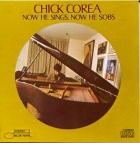
So that's it, basically. It's like a giant, something huge and mammoth, that's going "boom, boom, boom," and meanwhile everything else is going on, and turning around, and God knows what. I also came up with the rhythm for Gerald Cleaver to play on that second part. I don't know if you remember, but there's one point where the drums start doing that thing on the hi-hat, going in one dimension, and the rest of the drums are going another way in another time. I created this puzzle, this drum puzzle, and I taught it to him so that he would play in two dimensions at the same time, because this piece is about multidimensional things.
What the trio plays before that is really all just introduction to get to that point. It's an introduction to this climax.
AAJ: My favorite at the moment is "Gmoong." You've explained the whole process of how it comes from those chords and what each person has to say in relation to them. It's that trio of you, Randy Brecker and Bob Mintzer, but I find myself thinking of it as a quartet where the fourth member is orchestra.
MV: That's what it ends up being, yeah.
AAJ: It's as elegant as a Bach piece while not sounding like Bach at all. There's that same feeling of canon, or lines being rearranged. The balance of parts is so perfect. Was there ever a challenge doing these pieces of the orchestra being too prominent or not prominent enough?
MV: Of course there was. I had to follow my ears entirely in this area. And that goes for all the pieces—not just this one. I hear it—what can I tell you? I cannot write it with a pencil. I hear it. And when I hear it, I do it. So I know that if something is too loud, it's too loud. I know what I want to have—I know what I want the final outcome to be. So if something is too loud, or doesn't fit, it goes out! And this comes down to taste.
AAJ: I guess that's what composition comes down to.
MV: Yes, exactly, because you're in control. If you want something loud, you can have it that way. If you don't, you won't have it that way.
class="f-right">
A New Music: Neither Jazz Nor Classical
AAJ: You said "Universal Evolution" was particularly hard to mix. To me, it's the most strikingly new-sounding of all the pieces. It all feels structured around that ascending seven-note phrase and its variations. I love the choral fade-in as well, and it does have that perfect mixture of the open jazz form and the symphonic elements. I also think it's Gerald Cleaver's finest moment on the album.
MV: Well, I think you are right in every aspect of this. I also think that this is the most advanced piece on the album. I think it most represents what we were talking about before, which was where the music of the future will be coming from—the best of the classical field and the best of the jazz, or creative field. So it's classical sound blended with creative force. And this is the best example of this marriage. The melody's being played by the group, and when the saxophone comes in after the choir, you don't notice the difference. It's not like the choir does the introduction, and then this jazz saxophone starts to play. It is a continuation of the music—it's one piece, one baby, one blood.
And this is the idea, and this is what has been so difficult to achieve up to this point. A lot of people have tried to do this—to put classical and jazz music together—and I haven't heard anyone succeed. It was always two different musics put together, not one music. In this case, I think it is one music, and I think it's partly because I am that one musician who is classical and also a creative force. I am both. And that's the kind of musician who will produce this music in the future: Someone who is educated on both sides, who has the classical education and the jazz education.
Actually, I don't mean a jazz education; I just mean someone who's creative and who improvises. Because jazz is limited in its roles; it was just a stepping stone to the next thing, which is pure creative force. And the pure creative force needs some kind of a form, and it also needs to take advantage of the sounds which we have in the orchestra—the possibilities of those sounds. This is the next direction.
AAJ: An abandonment of segregation. Not classical-sounding jazz music, or jazzy classical music, but a new music.
MV: A music. Yes. Of course, it will require certain things that people not do. For example, you have to be sure that nobody is playing bebop [laughing]. That's why I have chosen people who do not play bebop phrases. Gary Campbell does not play bebop phrases, because I can't have those phrases in my music. They are outdated in the sense of what I am doing now. I guess you could say that they are from a different point of evolution.
And on this piece, when the band fades away and the orchestra plays that melody, it's the same melody as what the band was playing before. But it's played in a symphonic way. Then they join together, and they both play the same melody at the same time. And that was the idea.
AAJ: Well, they should play the same melody. It's not two songs. It's one.
MV: Right, right. But sometimes people don't recognize that it's the same melody, because it seems so different.
AAJ: You already talked about "Moment" and explained its creation. I do love how this one doesn't require or use any sort of crescendo or climax. It just ends. And that's the end of the album as well.
MV: Well, it's a moment, you know. It's what I thought a moment would be. It's a moment. An essence. And I think every piece on the album is like that—it's an essence. They are all completely different, but each is an essence. Like painting, like pictures. Different essences. And I'm very surprised by musical critics when they sometimes say, "Well, he's not playing like he usually is." If the jazz musicians in the past would step out and play something else, they would put them down because, you know, "It's not the way he usually plays."
It's really strange for me to have heard this in the past, because nothing can repeat itself! Everything is a new essence, all the time. So how can you say that this guy is going to play the same thing he did before? It's not even the same thing; it's another essence. As artists, we should be free to create any kind of essence that we feel is within our reach. Why should we be limited?
AAJ: Well, is it not a very common critical gesture to criticize an artist for continuing to do the same thing?
MV: [Sadly] It is, yeah. It is. It's a touchy point.
AAJ: You talk about your belief that this music does represent a way to go for the future. But for that to happen, more people will have to be able to do it well besides yourself. Do you think that could happen?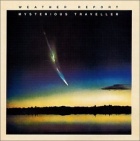
MV: I think it's already going that way. I see, especially in Europe, a lot of classical education going together with jazz education. That's also starting in America, but Europe is ahead in this at the moment. So it's slowly happening that the musicians are being educated in both sides, and so this nucleus is being created. That's the musician of the future—like we were talking about before. He'll have to know both, and he has to have his taste developed in that way we were talking about so the music has a certain class—so it doesn't become a German goulash, let me put it this way [laughing].
So musicians will know—they will hear it like I do. They'll know that this can be, and this cannot be. Nobody can tell you these things, but they will know it by having been experienced and educated in both worlds.
AAJ: I think it would have happened long ago if classically-trained musicians had ever been encouraged to improvise.
MV: I think so, but there are a few things involved. I was in education for seven years at the New England Conservatory, so I saw how it was. A big part is that classical musicians do not allow this to happen. They will not accept anything new, anything involving improvisation—because, basically, they are afraid of it.
In fact, I was trying to do some progressive stuff at the New England Conservatory, and I came across classical-music departments that just shut the door—they said, "No, you are not coming here. This is my job, this is my territory. I don't want anything new. Screw you." That's it, basically. I tried to improve the curriculum and bring something new, and they felt threatened.
So we are facing that. We are also facing the fact that, like you said, classical musicians don't improvise. Some of them really can't. That's hard for me to understand, because I was improvising from the beginning—except that there was a moment like that for me, in my life too, in the very beginning, so I do understand them not being able to improvise. At the beginning of my education, I would not know what to play in that respect. So I know this feeling. For me, it passed, and I was suddenly free to improvise. It can be frustrating though, not knowing what to play, and then you see this guy next to you who's improvising left and right, picking things out of the sky. Can you imagine how frustrating that would be for those classical musicians?
So this is what we have to deal with. But I think it's going to change, because those people are getting older and retiring. There's a new generation and a new consciousness coming in, and it's going to smooth out in time. In the next two or three decades, you're going to have musicians who will be educated in the way I'm talking about. I think it will happen.
class="f-right">
Recreating the Music Live: Difficult, But Not Impossible
AAJ: I know that this music would work fantastically live. Do you intend to perform it in concert?
MV: Yes. Those three pieces I was talking about, "Breakthrough," "A Prayer," and "Solar Giant"—I actually have the scores for them, because someone wrote the parts down from my MIDI files. So I have the scores. It was difficult to write it all down, because the orchestra parts sound so good because they're not in the regular space. They're much bigger, a sort of balloon sound, and this is almost impossible to achieve by just reading bar lines. Some of the things are in a slightly slower tempo than we are. That's how you create this space, and how in the hell are you going to do that live?
So it took this guy an incredible amount of time and effort to write this down. But I think it can work in a slightly different way. You have noticed that the orchestra is not playing all the time. They are playing statements. They are playing phrases. So if I teach an orchestra these statements and phrases in exactly that way, then it's only a question of a conductor giving them the start point to play that phrase at that moment. And when they do, we play our thing, and I already know what we do. So it's possible to perform it in this way that I'm describing. The orchestra learns the statement and plays it exactly the way they learned it when the conductor cues them. Otherwise, it will be very difficult to read this music from the notes. It's murder. If they just play within those bar lines, it will sound like student composition. It has to be free, and it has to breathe.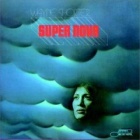
Otherwise, it will just sound bad. Written down, the orchestra's bars aren't our bars. And that kind of notation is another thing that will have to go, because it's so imperfect and so clumsy. You can hardly fit a performance into it anymore. If fact, you'd almost need two conductors to perform this music—one conducting in one time, and one in another time. Each is really relatively simple music, but the timing and placement is different.
AAJ: That might make it bad for you to, say, fly into Chicago and perform it that night with an orchestra. An orchestra might really have to rehearse it with you.
MV: Well, I think if the conductor got together with me and I showed him what sound I wanted, he could teach it to the orchestra. But he'd have to tell the orchestra to play the statements in this way. Then it would be possible. But if we came in, we would still need some days of rehearsal, or the orchestra would be completely cuckooed out: "What the hell are these guys doing?"
AAJ: Maybe an orchestra that has played a lot of Charles Ives compositions would do better with this music than one that hadn't.
MV: I would think so. It's very simple music, but it can be a catastrophe. My harmonies are so touchy that if you play a little bit out of tune, it's miserable. There's a certain tension within these things, and those chords are not the usual ones you would play.
I already played this kind of stuff a long time ago, and that's why I made my sample library. I wrote a bass concerto, and it was a complete disaster. They could not play it. Then during one rehearsal, there were 16 bars that were played exactly as they'd been written, and I thought, "My God, this is fantastic." Then I knew it was possible—but everything had to be played exactly right. It requires absolute precision, and they don't approach it that way, because for them it doesn't matter if you play a little bit late, or you're a little clumsy, or a little bit flat or sharp. But then it's an absolute disaster, because my music is like alchemy. If you start messing with the elements, the ingredients, of course it's going to get screwed up.
And this music is just a stepping stone, because ideally, an orchestra should be able to improvise. Then the creation to the creative force would be made on the state, live. But for that to happen, someone would have to write books on how to improvise in this way, so that there would be some kind of order to the improvisation. Then composers could work in this way, and orchestras would understand, "Oh, if there's an 'A' then we improvise in this way. If there's an 'A-1' then we improvise in this other way." So these improvisational limits could be incorporated into composers' pieces and the creative force could enter the symphonic hall. And I'm sure we are going this way.
class="f-right">
Vitous as Bassist: The Return of Arco
AAJ: You're, of course, very famous as a bassist—not just as a composer or leader. It seems that you're more interested in larger statements nowadays. It's been a while since you've done anything like your 1986 solo bass recording Emergence or your duet recordings with Jan Garbarek. Are you still interested in expressing yourself with the bass alone?
MV: Yes! Actually, I've just started to play arco again. And to my surprise, I'm playing better than ever, which is really good. The reason I stopped is that the amplification wasn't good enough, so when I was playing arco live it sounded like someone cutting wood. I'd be playing beautiful, velvet notes, and it would sound like someone cutting wood.
So I couldn't have that. I felt like the sounds I was making could kill somebody. So I put it down, because I just couldn't stand it. But I've picked it up again. Now there are better pickups and microphone systems that will actually make it sound pretty much like it is. So I'm happy about that, and I'm playing arco a lot now. In fact, on the next album—which I've almost finished recording—there's a lot of arco work. It's a group album without orchestra.
AAJ: Tell me more about it.
MV: Well, we are playing "Lonely Woman" by Ornette Coleman. We're playing [Wayne Shorter's] "Nefertiti." And I've created two new pieces. It's a quartet of [trumpeter] Franco Ambrosetti, Gary Campbell, Gerald Cleaver and myself. Sometimes Michel Portal comes in and joins us, so I'm writing for the horns, but with the arco bass, it actually almost sounds bigger than an orchestra. It's some fantastic new stuff, and we'll be able to tour the album. It's very difficult to tour an album like Universal Syncopations II, you know. Impossible, in fact.
align=center>
AAJ: It would be very expensive.
MV: Yes, even though I can have some of those files taken down to the computer and trigger the orchestra parts from the keyboard, like I do anyway in live performances. We could almost perform the identical thing with the trio. Almost.
And I'm already working on Universal Syncopations III. That's also halfway finished.
AAJ: Do you work in the studio every day?
MV: Yes, absolutely. I have a complete professional studio at home. I'm not recording every day—I'm working on editing, that sort of thing. There's so much to do. Plus I have to learn new things. I'm always discovering and inventing all kinds of things.
Selected Discography
Miroslav Vitous, Universal Syncopations II (ECM, 2007)
Miroslav Vitous, Universal Syncopations (ECM, 2003)
Miroslav Vitous, Jan Garbarek, Atmos (ECM, 1993)
Miroslav Vitous, Guardian Angels (Evidence, 1993)
Jan Garbarek, Miroslav Vitous, Peter Erskine, Star (ECM, 1991)
Larry Coryell, Miroslav Vitous, Quartet (Jazzpoint, 1988)
Laszlo Gardony, The Secret (Antilles/New Directions, 1988)
Miroslav Vitous, Emergence (ECM, 1986)
Miroslav Vitous, Journey's End (ECM, 1983)
Chick Corea, Trio Music (ECM, 1982)
Terje Rypdal, To Be Continued (ECM, 1981)
Miroslav Vitous, Miroslav Vitous Group (ECM, 1981)
Miroslav Vitous, First Meeting (ECM, 1980)
Terje Rypdal, Miroslav Vitous, Jack DeJohnette, Terje Rypdal, Miroslav Vitous, Jack DeJohnette (ECM, 1979)
Miroslav Vitous, Miroslav (Arista Freedom, 1977)
Miroslav Vitous, Magical Shepherd (Warner Bros., 1976)
Miroslav Vitous, Majesty Music (Arista, 1976)
Weather Report, Mysterious Traveller (Columbia, 1974)
Weather Report, I Sing the Body Electric (Columbia, 1972)
Weather Report, Weather Report (Columbia, 1971)
Joe Zawinul, Zawinul (Atlantic, 1971)
Wayne Shorter, Super Nova (Blue Note, 1970)
Herbie Mann, Live at the Whisky a Go Go (Atlantic, 1969)
Chick Corea, Now He Sings, Now He Sobs (Solid State, 1968)
Herbie Mann, Windows Opened (Atlantic, 1968)
Photo Credits
Top photo: Robert Zlatohlavek
Second photo: Myles Rothstein
Third photo: Robert Masotti
Fourth photo: Courtesy of Miroslav Vitous
Tags
PREVIOUS / NEXT
Support All About Jazz
 All About Jazz has been a pillar of jazz since 1995, championing it as an art form and, more importantly, supporting the musicians who make it. Our enduring commitment has made "AAJ" one of the most culturally important websites of its kind, read by hundreds of thousands of fans, musicians and industry figures every month.
All About Jazz has been a pillar of jazz since 1995, championing it as an art form and, more importantly, supporting the musicians who make it. Our enduring commitment has made "AAJ" one of the most culturally important websites of its kind, read by hundreds of thousands of fans, musicians and industry figures every month.



